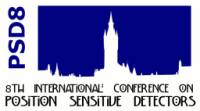Speaker
Ms
Laura Harkness
Description
Conventional gamma -camera systems utilise mechanical collimation to provide information on the position of an incident gamma-ray photon. Systems that use electronic collimation utilising Compton Image reconstruction techniques have the opportunity to offer huge improvements in detection sensitivity. Such systems have been previously limited by the relatively poor energy resolution of the detector material used in the camera. The University Of Liverpool Department Of Physics have been evaluating position sensitive High Purity germanium (HPGe) detector systems as part of a Single Photon Emission Computed Tomography (SPECT) gamma Compton Camera system. Data has been acquired from the SmartPET detectors, operated in Compton Camera mode. These orthogonally segmented planar detectors are designed for the energy range of small animal PET imaging [1]. The minimum in the energy range of the current system is 244keV [2] due to the 20mm thickness of the first scatter detector. This thickness of germanium causes a large proportion of gammas with energy less than 244keV to be completely absorbed in the detector, rather than scatter through it. Results are presented on the outcome of a Geant4 [3] simulation designed to optimise the geometry of a new germanium Compton Camera system for the energy range of medical applications.
[1] R.J. Cooper et al., Nuclear Instruments and Methods in Physics Research A 579 (2007) [2] H.C. Boston et al., IEEE Nuclear Science Symposium Conference Record (2006) [3] S. Agostinelli, Nuclear Instruments and Methods in Physics Research A 506 (2003) 250-303

